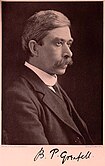Papyrus 115
P. Oxy. 4499 | |
| Text | Rev 2-3, 5-6, 8-15 |
|---|---|
| Date | c. 275 |
| Found | Oxyrhynchus, Egypt |
| Now at | Ashmolean Museum |
| Cite | Juan Chapa, Oxyrynchus Papyri 66:11-39. (#4499) |
| Size | 26 fragments; 15.5 x 23.5 cm; 33-36 lines/page |
| Type | Alexandrian, close agreement with A & C |
| Category | I |
| Note | Gives number of the beast as 616 |
Papyrus 115 (P. Oxy. 4499), designated by 𝔓115 (in the Gregory-Aland numbering of New Testament manuscripts) is a fragmented manuscript of the New Testament written in Greek on papyrus. It consists of 26 fragments of a codex containing parts of the Book of Revelation. [1] Using the study of comparative writing styles (palaeography), the manuscript is dated to the third century, c. 225-275 AD.[2] Scholars Bernard Pyne Grenfell and Arthur Hunt discovered the papyrus in Oxyrhynchus, Egypt.
𝔓115 was not deciphered and published until 2011. It is currently housed at the Ashmolean Museum.[3]
Description
The manuscript is a codex (precursor to the modern book) although in a very fragmentary condition. In its original form it had 33-36 lines per page of 15.5 cm by 23.5 cm. The surviving text includes Revelation 2:1-3, 13-15, 27-29; 3:10-12; 5:8-9; 6:5-6; 8:3-8, 11-13; 9:1-5, 7-16, 18-21; 10:1-4, 8-11; 11:1-5, 8-15, 18-19; 12:1-5, 8-10, 12-17; 13:1-3, 6-16, 18; 14:1-3, 5-7, 10-11, 14-15, 18-20; 15:1, 4-7.[1]
The manuscript has evidence of the following nomina sacra (names/titles considered sacred in Christianity): ΙΗΛ (Israel), ΑΥΤΟΥ (his), ΠΡΣ (Father), ΘΩ/ΘΝ/ΘΥ (God), ΑΝΩΝ/ΑΝΟΥ (man), ΠΝΑ (Spirit), ΟΥΝΟΥ/ΟΥΝΟΝ/ΟΥΝΩ (heaven), ΚΥ (Master/Lord).
The manuscript uses the Greek numeral system, with no number extant as being written out in full.[1]
The manuscript is considered to be a witness to the Alexandrian text-type, following the text of Codex Alexandrinus (A) and Codex Ephraemi Rescriptus (C).[4]
An interesting element of 𝔓115 is that it gives the
According to the transcription of the INTF, a conjectured reading of the manuscript, due to the space left, is [χξϛ] η χιϛ (666 or 616), therefore not giving a definite number to the beast.[5]
Some notable readings[6]
- δ/τεσσάρων (fourth)
- λεγουσαι (they said) : 𝔓115 𝔓47 א C 051 1006 1611 1841 1854 2329 2344 A
- λεγοντες (saying) : A 2053 2351 K.
- το ονομα (name) : 𝔓115 co Bea.
- τα ονοματα αυτων (their names) : 𝔓47 א P 051 1006 1841 2329 al lat
- το ονομα αυτου (his name) : C 1854 2053 pc Irlat Prim.
- κατοικουντας (who inhabit) : 𝔓115 A 2049 69.
- καθημενους (dwelling) : 𝔓47 א C P 1611 1854 2053 2329 pc syp, h Or
- βχ (2600) : 𝔓115.
- αχ / χιλιων εξακοσιων (1600) : 𝔓47 אc2 A 42 69 82 93 177 325 456 498 627 699 1849 2138 2329 Majority of manuscripts
See also
- List of New Testament papyri
- Oxyrhynchus papyri
- Stigma (letter)
References
- ^ ISBN 978-0-8423-5265-9.
- ^ Juan Chapa, Oxy. Pap., 66:11-39, no. 4499
- ^ "Liste Handschriften". Münster: Institute for New Testament Textual Research. Retrieved 27 August 2011.
- ^ Comfort, Philip Wesley (2005). Encountering the Manuscripts. An Introduction to New Testament Paleography & Textual Criticism. Nashville, Tennessee: Broadman & Holman. p. 77.
- ^ "Institute for New Testament Textual Research Papyrus 115 Transcription". Retrieved 26 September 2022.
- ^ Taken from NA27 Edition Apparatus, and http://ntvmr.uni-muenster.de/nt-transcripts Archived 13 June 2015 at the Wayback Machine
Further reading
- Walter de Gruyter, Berlin, 2009, pp. 73–92.
External links
- Oxford University 'P. Oxy. LXVI 4499'
- Images of the fragments of P. Oxy. LXVI 4499



